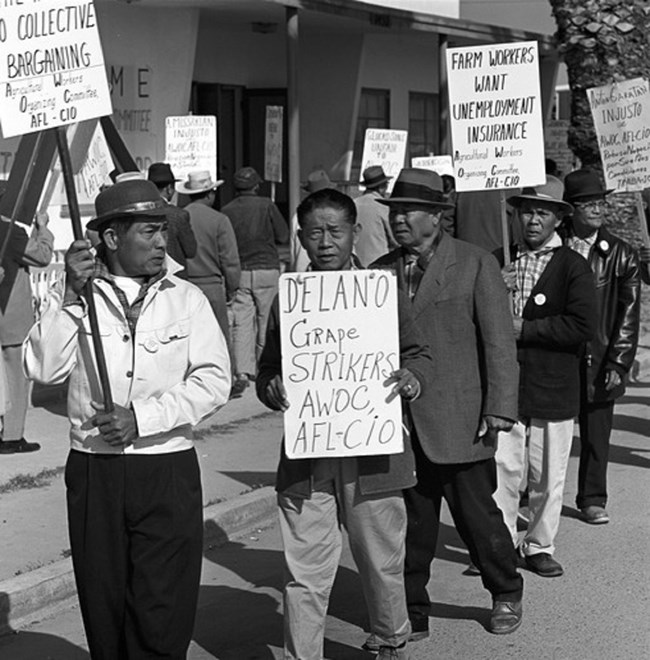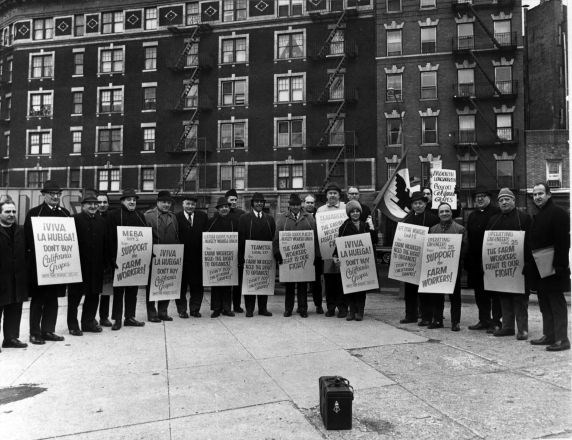Part of a series of articles titled The Road to Sacramento: Marching for Justice in the Fields.
Previous: A New Era of Farmworker Organizing
Article

© Harvey Richards Media Archive
The decision to strike was full of risk for farmworkers and their families. In addition to lost wages, many also faced eviction from housing owned by growers. Nonetheless, in the fall of 1965, thousands of workers in the Delano grape fields voted in favor of striking This article explores the early months of the strike as well as the successful consumer boycott campaign initiated by the National Farm Workers Association.
They demanded a raise both in their hourly wages, from $1.25 to $1.40, and in the piece rate (the pay a worker earned for each box of grapes packed). The strikers wanted the piece rate to go up from ten cents a box to twenty-five cents.
Two veteran organizers, Larry Itliong and Ben Gines, led the strike. Only a few months earlier, AWOC had won similar concessions for grape workers in the Coachella Valley, which gave the Delano strike added urgency. Both actions had ties to the wave of farmworker strikes that followed the termination of the Bracero Program in 1964. Eager to extend the union’s victory at Coachella to the vineyards of Delano, members of the AWOC local met at Filipino Hall and voted for a strike.
This decision was a big risk for Delano’s grape workers. Many lived in company housing and could be evicted with little or no notice, and, indeed, many eventually were forced to leave their homes as a consequence of striking. There was also a risk that the growers might draw from the large population of Mexican and Mexican American farmworkers to replace the striking Filipino crews. Such tactics had long been an effective check on union power. But 1965 was not the past. The National Farm Workers Association (NFWA) had now emerged as an influential force in the community. The fledgling organization’s leadership had two choices: join the strike or break it.
The NFWA leadership, including Cesar Chavez, didn’t feel ready for the strike. Just three years old, the young organization was still finding its footing - both financially and in the community. They were building a movement and did not know if they had the resources to commit to a strike. Yet they also knew that the Association wasn’t going to undercut the AWOC action. So, despite Chavez's reservations, on September 16, 1965, Mexican Independence Day, the NFWA membership met at Our Lady of Guadalupe church in Delano to hold a strike vote. The NFWA membership voted overwhelmingly in favor of the strike, and within a few days, NFWA was picketing ten additional vineyards, in addition to the sites already targeted by AWOC.
Despite this remarkable show of unity by the farmworkers, the region’s growers were confident that they could defeat this latest attempt at organizing and they refused to negotiate with the farmworkers on strike. Instead, they hired replacement workers, or "scabs," from elsewhere in California and as far away as Oregon, Texas, and Mexico to complete the fall 1965 harvest. But although the harvest ended without the farmworkers achieving their objectives, the struggle was just beginning. What began as a labor dispute in the fields of Delano blossomed into a civil rights struggle, a movement for achieving justice for farmworkers.

Image by Larry Gross. Walter P. Reuther Library, Archives of Labor and Urban Affairs, Wayne State University.
Indeed, the founders had consciously shied away from that title and offered many services beyond a typical labor organization. Chavez had organized the NFWA around the premise that the farm workers’ struggle was part of a much broader movement for civil rights. The ongoing Black Freedom Struggle provided both inspiration and allies to the farm workers. During the strike, organizers from the Student Nonviolent Coordinating Committee (SNCC) and the Congress of Racial Equality (CORE), along with student activists from the Bay Area, arrived in Delano to offer support, drawing parallels between the Jim Crow South and rural California in the fight for racial justice.
NFWA leadership knew that picket lines and local protests would not be enough to achieve their objectives. Their members lacked even basic legal protections and could be fired and evicted from company housing with little recourse. In addition, the growers had access to replacement labor and enjoyed significant political influence in Sacramento and Washington, D.C. In order to win representation, the union would have to engage in creative and unorthodox tactics.
One strategy that proved especially effective was the boycott. Labor organizations, including most AFL-CIO unions, faced strict restrictions when it came to boycotting companies or products. A primary, or direct, boycott, which targeted the employer involved in a labor dispute, was generally allowable. Workers could legally strike or picket their employer, for example, though companies did try to limit even these actions. However, when it came to targeting other associated companies, like a bank providing financing, or a store selling an employers’ goods, the workers could not use similar tactics. These types of actions are called secondary boycotts, and workers were forbidden engaging in this form of protest by the 1947 Taft-Hartley Act, an amendment to the National Labor Relations Act (NLRA). However, because farmworkers were explicitly excluded from federal labor laws, the Taft-Hartley restrictions did not apply to them.
So, in December 1965, the NFWA called for its first boycott. The target was Schenley Industries, the second largest grower in Delano. Schenley was a nationally known company, with millions in liquor sales each year. This made the company an attractive and highly visible target for the farm workers. Organizers and volunteers gathered in cities across the country to generate support, picketing businesses like grocery stores, bars, and liquor stores that sold Schenley products. Most importantly, they also appealed to other unions not to buy or sell Schenley products. With the support of unions like the hotel and restaurant workers unions, Schenley suffered a significant drop in sales by April of 1966. The bad publicity from the boycott also hurt the company’s image. This pressure would eventually bring Schenley to the bargaining table to sign a labor agreement with the NFWA, the union’s first.
The Schenley boycott was only the beginning. Over the next decade, the union would repeatedly make use of the boycott, refining its strategy and approach depending on the crop and the employer. The tactic proved remarkably effective in nationalizing the farmworker struggle and - to some extent - neutralizing the effects of the financial and political power imbalance that existed between growers and workers in the Central Valley.
What began as a fight for higher wages in Delano had now become a referendum on the right of farmworkers to organize and enjoy basic labor protections. Specifically, the NFWA targeted the exclusion of farmworkers from the National Labor Relations Act, which had enabled growers to refuse to recognize farmworker unions for decades. But the recent passage of the Civil Rights Act of 1964 had created a new framework for farmworker organizing. Economic justice was social justice, and the NFWA demanded federal intervention on the basis of farmworkers’ rights as citizens. Chavez argued this point before the U.S. Senate Subcommittee on Migratory Labor in 1966, stating: “The whole system of occupational discrimination must be killed just like the discrimination against people of color is being challenged in Washington. This, and nothing more, is what farmworkers want.” For Chavez and the NFWA, this meant granting farm workers the explicit right to form unions and collectively bargain with growers--the same rights enjoyed by workers in most other professions in the United States.
The farmworkers’ movement was inseparable from the movement for civil rights. The boycott had the potential to exert real economic pressure on the growers, perhaps even enough to finally bring them to the negotiating table. But the strike was more than an economic issue to the farm workers of Delano: it was about their basic rights as American workers. To focus national attention on this aspect of the movement, the AWOC and NFWA turned to another civil rights strategy: the march.
Bibliography
Araiza, Lauren. To March for Others: The Black Freedom Struggle and the United Farm Workers. First ed. Politics and Culture in Modern America. Philadelphia: University of Pennsylvania Press, 2014.
Bardacke, Frank. Trampling out the Vintage : Cesar Chavez and the Two Souls of the United Farm Workers. New York: Verso, 2011.
Jenkins, J. Craig. The Politics of Insurgency: The Farm Worker Movement in the 1960s. New York: Columbia University Press, 1985.
Levy, Jacques E., and Chavez, Cesar. Cesar Chavez: Autobiography of La Causa. 1st ed. New York: Norton, 1975.
Shaw, Randy. Beyond the Fields: Cesar Chavez, the UFW, and the Struggle for Justice in the 21st Century. Berkeley: University of California Press, 2008.
Part of a series of articles titled The Road to Sacramento: Marching for Justice in the Fields.
Previous: A New Era of Farmworker Organizing
Last updated: March 20, 2025